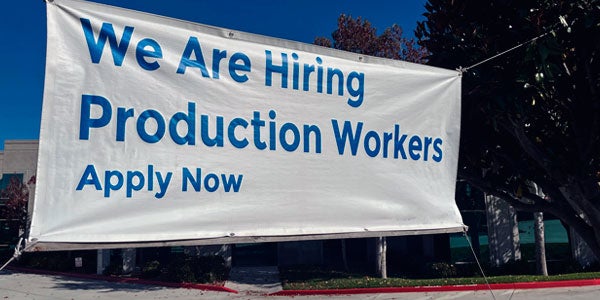Skyrocketing inflation without a clear end in sight has businesses and consumers rethinking their financial strategies for 2022. Now is the time to not only secure your business prospects for the coming months but also to inflation-proof your operations for future spikes. With strategic changes and precautions, you could make 2022 more profitable than pre-Covid returns—inflation or not!
Jump To...
Causes of inflation | Covid-19 pandemic | Financial health evaluation | Operating profit margin | Shareholder profitability assessment | 2022 financial strategy | RPA (robotic process automation) | Hybrid work | Tech investment for hybrid | Pricing structure | USP (unique selling proposition) | Automation and artificial intelligence | Customer satisfaction | Specific industry strategies
Inflation 2022: What does this really mean today? The cost of fuel, groceries, utility bills, and housing has soared, and Americans are feeling the pinch after a challenging few years.
The Bureau of Labor Statistics revealed in December that year-over-year consumer prices had risen 7.0%, marking the highest annual jump since December 1990. Considering how the Fed sets 2.0% as the standard annual inflation target, this is an outsize jump.

Skyrocketing inflation without a clear end in sight has businesses and consumers rethinking their financial strategies for 2022.
One of the difficulties in planning ahead is the hot public debate about whether this rate of inflation will continue throughout the year. Some economists are confident that the pressure is temporary and will ease within the coming months. Others, however, suggest that Americans should adapt to the changing environment and adjust financial approaches assuming little relief in sight. Toward the end of last year, Fed Chair Jerome Powell even made the call to drop the word “transitory” from inflation descriptions—a sign that the marks of this inflation 2022 spike may be a new piece of the “new normal”.
Whether the current period of inflation ends up transitory or not, the fact remains that businesses must make real efforts to shift their business practices now if they want to ride out a bumpy 2022. Now is the time to not only secure your business prospects for the coming months but also inflation-proof your operations for future spikes. With strategic changes and precautions, you could even make 2022 more profitable than pre-Covid returns—inflation or not.
What’s Driving Inflation in 2022?
The inflation 2022 driving factors include housing, vehicles, and the stock market, all of which play an integral part in business, consumer, and investors' buying power.
As prices increase over time, the value per dollar falls, thus decreasing purchasing power. Inflation is inevitable and multifaceted in our modern economy, driven at different times by a whole host of reasons. The tug-of-war between supply and demand are, at the foundation, the most common culprit behind annual inflation.
However, the past few years of the Covid-19 pandemic have brought exacerbating circumstances. The sudden shutdown of the world economy at the start of 2020 drove the just-in-time manufacturing model off a cliff; meanwhile, consumers locked inside for months on end switched their purchasing habits from services to goods—which require manufacturing.
As global economies reopened (and then closed and reopened again in some instances) demand increased more quickly than anticipated. Supply chain bottlenecks off and worldwide labor shortages have only deepened the problem. With many of these extenuating factors continuing into well into 2022, and the emerging geo-political developments, it seems inflation will be with us in one way or another for at least this year.
Weather Inflation 2022 With Smart Business Strategies
Inflation is a challenge for everyone, and with some careful planning and adjustment of your standard business practices, your business can weather the storm and not just survive, but thrive. Assess how you can incorporate these strategies into your practice to best beat inflation in 2022.
Evaluate Your Company’s Financial Health
In order to assess the best strategies for going forward, you have to know where you’re starting from. Any plan for mitigating the impact of inflation has to start with an clear assessment of your company’s current financial situation.
Start by pouring over all your company financial statements. Although net income offers an insight into overall profitability, it isn’t the only factor in evaluating your financial health. After you deduct company expenses—including production, depreciation, tax, and labor—your net income reflects profit value.
Your operating profit margin, on the other hand, indicates company earnings before interest and taxes. This is an important efficiency indicator, as it reflects how effective managers are at monitoring expenses and generating revenue. A high operating profit margin indicates effective cost management and successful sales generation.

An itemization of assets and liabilities can also help paint a picture of the business’ debt situation and overall financial health. Debt ratios determine a company's ability to deal with outstanding debt; meanwhile, major capital expenditures (over $1 million) can be used in assessing both your current financial condition and potential for growth.
Stock Price and Shareholder Profitability Assessment
Another method to evaluate your company’s financial health, especially when drawing investors, is assessing the company's stock price and profitability for shareholders via the earnings per share (EPS). In addition to EPS, the dividend payout ratio is another metric for tracking returns to shareholders, financial stability, and growth. This ratio exposes the percentage of company earnings paid to equity investors. The higher the value, the more financially stable the business. The retained earnings then indicate the portion of profits reinvested for business expansion.
Take Strategic Financial Action
So you’ve completed your assessment; now it’s time to strategize. Considering the unpredictability of 2022, beating inflation will require more than just cutting costs. Your game plan needs to include scalable growth and thoughtful reinvestment programs to deliver stronger purchasing and pricing capabilities. Your goal is to minimize reliance on volatile labor markets and maximize top-line revenue, all while maintaining high employee retention rates.
Detailed spending visibility is the basis of expense management. In volatile periods, it is essential to establish end-to-end spending transparency to maximize accountability, ensuring that action is taken with foresight of the full impact. This visibility allows management to then differentiate between necessary and frivolous spending, and better align costs with strategy.
Comb through every expense to pinpoint the real drivers of cost in this inflationary climate. This analysis is your foundation to taking steps like establishing a preferred vendor program, re-evaluating in-house adoption vs. outsourcing core functions, and implementing AI-powered tools.

Companies can still reduce consumption, even in the face of producer pricing pressures and supply chain difficulties—they just may have to reorganize their work flow. Cross-functional spending controls will zero in on what costs you can avoid by doing things differently. It will also highlight spending that is no longer justifiable, and ensure that it doesn’t creep back over time.
In the face of rising labor costs and a worker shortage, cut out all the unnecessary manual work you can. Similarly to cutting extraneous costs, a comprehensive and rigorous evaluation of work activities will help you determine what functions are essential to business, and what can go. The idea isn’t to cripple your company by removing core functions—it’s to make daily operations more efficient.
In instances where you cannot remove an operation wholesale, see if you can automate it instead. RPA (robotic process automation), intelligent workflow, and document processing technologies allow workers to focus on value-based tasks. Many businesses spend significant hours on manual data inputs—automation can save on labor costs and eliminate human error in the process.
Embrace Hybrid Work to Save on Office Spaces and Manage Labor Costs
The sudden onset of Covid-19 forced many companies to quickly evolve their workforce to a hybrid or remote model. Now two years in, many have embraced this as the new normal and here to stay. If you have not yet considered making a hybrid work model part of your regular operations, now is the time. Not only will this save you operational costs; in a labor-friendly market, the incentive of working remotely or flexibly can help you retain talent.
The transition to hybrid work can come as a gift for your wallet; however, you want to make sure you understand the tax and employment compliance aspects of maintaining such workforces.
Clearly defining who in your company structure can work remote or hybrid (and in what capacity) from the start is essential for organizational purposes. Apply these criteria objectively and consistently—with some room for flexibility to address employee changes in pay structure, employee status, or worker category effectively.
It is important to also remember that in a remote structure, workers are bound by the regulations of the state in which they work—not where their employer is based. This includes wages and worker compensation, leave of absence, payroll tax, corporate tax obligations, and reporting requirements. Speak to your trusted CPA about strategies like limiting geographical locations from which employees can work, or limiting the time that employees may work outside of designated states.

Other organizational policies may also need adjustment for hybrid or remote employees, including factors such as expense reimbursement, work hours, synchronous vs. asynchronous work, leave of absences, privacy, and data security. To prevent any financial, employee, and organizational inconsistency, make sure you clearly communicate all expectations with remote employees, and that they agree to abide by the remote or hybrid work policy.
A Note on Tech Requirements for Hybrid Work

New remote and hybrid work models require different tech investments than on-site models. The requirements now extend beyond the standard office desktop and internet connection. However, many of these changes need not require an increased budget—rather, take the time to reallocate your tech investments. For example, money from hardware budgets can now flow to other areas, such as improved collaboration tools and network security.
Companies that downsize physical office centers can redirect property and utility cost savings towards IT infrastructure. Cloud computing tools, security technologies, digital tools and remote training will better retain employees and prepare your company to be successful in today’s environment and the future.
Partnering with an expert in business financial solutions like New Mexico Bank & Trust, a division of HTLF Bank can help you manage your cashflow and your balance sheet to meet the needs of your new workforce model.
Consider Adjusting or Revamping Your Pricing Model
To truly optimize your business for this turbulent time, everything has to be on the table—including your pricing structure. Although many like to think they can simply reduce internal costs to save the day, this alone does not always solve the problem. In an ever-changing economy, you have to stay flexible enough to meet the market where it is to remain competitive. Businesses should analyze various pricing strategies to determine whether there are models that offer increased returns.
The first step is to understand your unique selling proposition (USP). Although there are always cheaper alternatives to a product, there’s nothing like a well-established business-customer relationship. When a business delivers robust personal service and guaranteed satisfaction, it can price and market accordingly.
This ties in with a push toward value-based (as opposed to cost-based) pricing. While initial value-based pricing may not align with where your sustainable model will end up, it may help build or regain a loyal base of customers.
Working with prospective customers to optimize your pricing strategy will help you determine what they value—and how much they are willing to pay. For example, customers may prefer a pay-per-use model, in which you only offer a subscription model. (In fact, a study from OpenView found that usage-based pricing models have increased in popularity by 32% since 2020.) It is important to meet your customers where they are. Remember that price is only one part of the equation.
When determining your pricing model, also consider how aggressive your growth strategy is. Premium pricing can reinforce a luxury brand image. Alternatively, you might benefit from quickly taking the market by undercutting competitor pricing. The exact strategy you choose will depend on what you are selling, alternatives available to the customer, and your growth strategy.

Essentially, you need to align your pricing strategy with your business strategy. This will help maximize customer lifetime value and in turn, positively impact your bottom line.
Leverage Automation and Artificial Intelligence to Increase Productivity
Leveraging automation is one of the most significant ways you can inflation-proof your business. Automation is a strategic long-term investment. While you may face initial implementation costs, automating workflow can turn a profit in the long run. Reducing manual administrative activities and labor will directly increase profit margins and allow you to redirect funds elsewhere.
In addition to improving cost-efficiencies, automation also frees up human capital and potential. With fewer tedious tasks to complete, employees can be assigned to high-value activities which often wind up neglected due to do backlogged administrative miscellanea. Managers are also freed up to direct resources more effectively.
In fact, a report by WorkMarket found that 53% of workers said they can save two hours a day through automation. According to the same data, 78% of managers believe it could free up to three work hours a day! Annually, this would save six weeks of labor hours for regular employees and nine weeks of productive work time for management.
But not only does automation reduce labor hour costs—it also reduces labor turnover. High employee turnover rates generally occur in positions centered around repetitive, mundane tasks. When employees are relieved from repetitive, overly complex manual tasks and assigned engaging activities, satisfaction naturally increases. This increased satisfaction translates directly to better retention rates and work performance.
Automation can satisfy the labor clock and employees; why not customers as well? The increased precision that comes with automated services can lead to happier and more loyal clients.
Whether it’s a data capturing error, email-typo, or data breach, human error at some point in the workflow is inevitable. According to IDC, errors in data handling and processing cost multinational corporations an estimated $62.4 million annually. Unlike humans, machines do not fluctuate in attention and follow program requirements continually. Thus, automated workflows result in consistent output every time—and happier customers who get exactly what they expect.
With these happier customers comes enhanced data collection, so you have a more exact understanding of what makes your client base happy. You can use this data to improve personalized service and streamline customer communications to build customer loyalty.
Inflation-Proof Your Business for the Coming Year
Businesses are no strangers to market fluctuations; however, the challenges inflation brings in 2022 are uniquely acute and unpredictable. Supply chains continue to languish and the labor market is unusually volatile—and yet demand remains high.
To tackle these challenges, companies need to think beyond curbing costs and leave no stone unturned. From CRE developers and fleet owners, to franchisees and AgriBusiness owners, businesses may need to change workflows, seek new vendors, and embrace scalable growth in order to not just outlast this period, but also safeguard against future problems. Take 2022 as a chance to reorient and inflation-proof your business.
While building your plan to beat inflation pressures, be sure to find a reliable partner who can offer sound financial guidance. With so many moving parts, you need to balance solving short-term problems and achieving long-term growth goals. An experienced financial partner can help you navigate the current environment and toward a brighter future. Contact New Mexico Bank & Trust, a division of HTLF Bank today to chart your course to success for the coming year.





